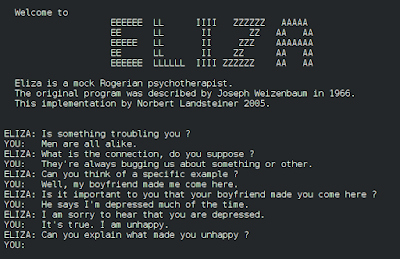ELIZA is a conversational computer software created
by German-American computer scientist Joseph Weizenbaum at Massachusetts
Institute of Technology between 1964 and 1966.
Weizenbaum worked on ELIZA as part of a groundbreaking
artificial intelligence research team on the DARPA-funded Project MAC, which
was directed by Marvin Minsky (Mathematics and Computation).
Weizenbaum called ELIZA after Eliza Doolittle, a fictitious
character in the play Pygmalion who learns correct English; that play had
recently been made into the successful film My Fair Lady in 1964.
ELIZA was created with the goal of allowing a person to
communicate with a computer system in plain English.
Weizenbaum became an AI skeptic as a result of ELIZA's
popularity among users.
When communicating with ELIZA, users may input any statement
into the system's open-ended interface.
ELIZA will often answer by asking a question, much like a
Rogerian psychologist attempting to delve deeper into the patient's core ideas.
The application recycles portions of the user's comments
while the user continues their chat with ELIZA, providing the impression that
ELIZA is genuinely listening.
Weizenbaum had really developed ELIZA to have a tree-like
decision structure.
The user's statements are first filtered for important
terms.
The terms are ordered in order of significance if more than
one keyword is discovered.
For example, if a user writes in "I suppose everyone
laughs at me," the term "everybody," not "I," is the
most crucial for ELIZA to reply to.
In order to generate a response, the computer uses a
collection of algorithms to create a suitable sentence structure around those
key phrases.
Alternatively, if the user's input phrase does not include
any words found in ELIZA's database, the software finds a content-free comment
or repeats a previous answer.
ELIZA was created by Weizenbaum to investigate the meaning
of machine intelligence.
Weizenbaum derived his inspiration from a comment made by
MIT cognitive scientist Marvin Minsky, according to a 1962 article in
Datamation.
"Intelligence was just a characteristic human observers
were willing to assign to processes they didn't comprehend, and only for as
long as they didn't understand them," Minsky had claimed (Weizenbaum
1962).
If such was the case, Weizenbaum concluded, artificial
intelligence's main goal was to "fool certain onlookers for a while"
(Weizenbaum 1962).
ELIZA was created to accomplish precisely that by giving
users reasonable answers while concealing how little the software genuinely
understands in order to keep the user's faith in its intelligence alive for a
bit longer.
Weizenbaum was taken aback by how successful ELIZA became.
ELIZA's Rogerian script became popular as a program renamed
DOCTOR at MIT and distributed to other university campuses by the late
1960s—where the program was constructed from Weizenbaum's 1965 description
published in the journal Communications of the Association for Computing
Machinery.
The application deceived (too) many users, even those who
were well-versed in its methods.
Most notably, some users grew so engrossed with ELIZA that
they demanded that others leave the room so they could have a private session
with "the" DOCTOR.
But it was the psychiatric community's reaction that made
Weizenbaum very dubious of current artificial intelligence ambitions in
general, and promises of computer comprehension of natural language in
particular.
Kenneth Colby, a Stanford University psychiatrist with whom
Weizenbaum had previously cooperated, created PARRY about the same time that
Weizenbaum released ELIZA.
Colby, unlike Weizenbaum, thought that programs like PARRY
and ELIZA were beneficial to psychology and public health.
They aided the development of diagnostic tools, enabling one
psychiatric computer to treat hundreds of patients, according to him.
Weizenbaum's worries and emotional plea to the community of
computer scientists were eventually conveyed in his book Computer Power and
Human Reason (1976).
Weizenbaum railed against individuals who neglected the
presence of basic distinctions between man and machine in this — at the time —
hotly discussed book, arguing that "there are some things that computers
ought not to execute, regardless of whether computers can be persuaded to do
them" (Weizenbaum 1976, x).
~ Jai Krishna Ponnappan
You may also want to read more about Artificial Intelligence here.
See also:
Chatbots and Loebner Prize; Expert Systems; Minsky, Marvin; Natural Language Processing and Speech Understanding; PARRY; Turing Test
Further Reading:
McCorduck, Pamela. 1979. Machines Who Think: A Personal Inquiry into the History and Prospects of Artificial Intelligence, 251–56, 308–28. San Francisco: W. H. Freeman and Company.
Weizenbaum, Joseph. 1962. “How to Make a Computer Appear Intelligent: Five in a Row Offers No Guarantees.” Datamation 8 (February): 24–26.
Weizenbaum, Joseph. 1966. “ELIZA: A Computer Program for the Study of Natural Language Communication between Man and Machine.” Communications of the ACM 1 (January): 36–45.
Weizenbaum, Joseph. 1976. Computer Power and Human Reason: From Judgment to Calculation. San Francisco: W.H. Freeman and Company






